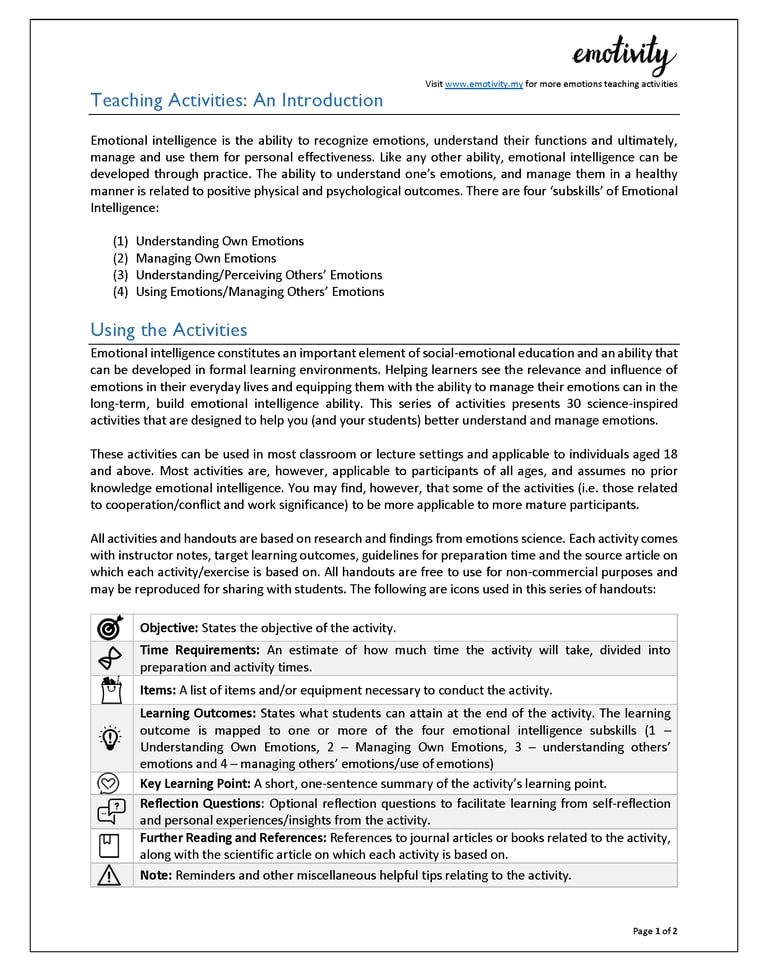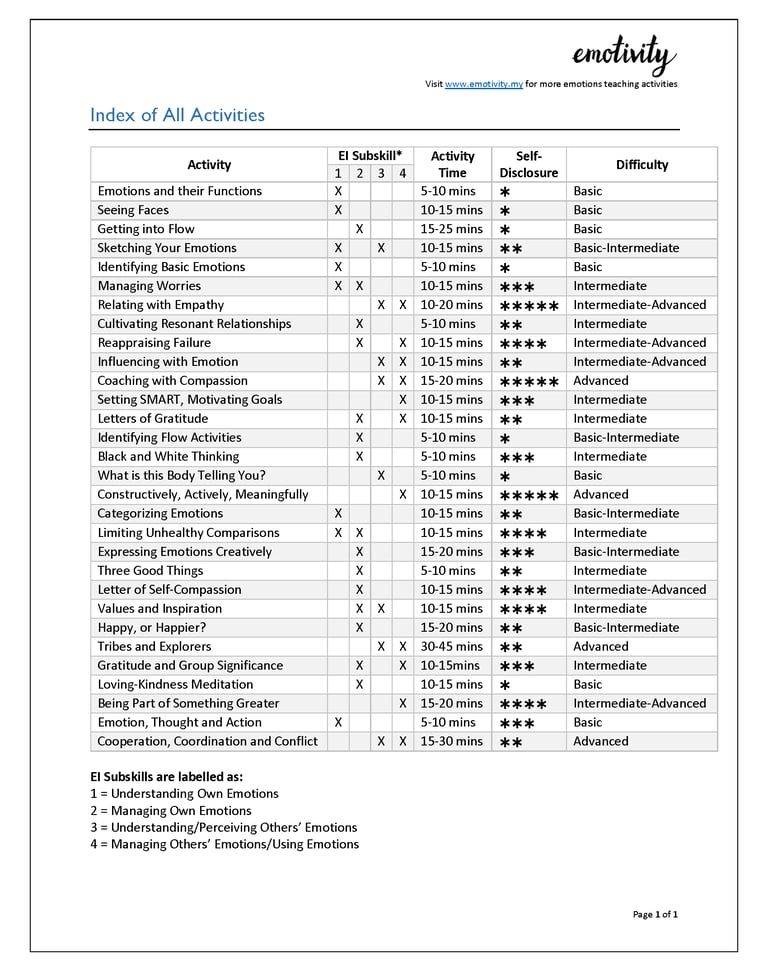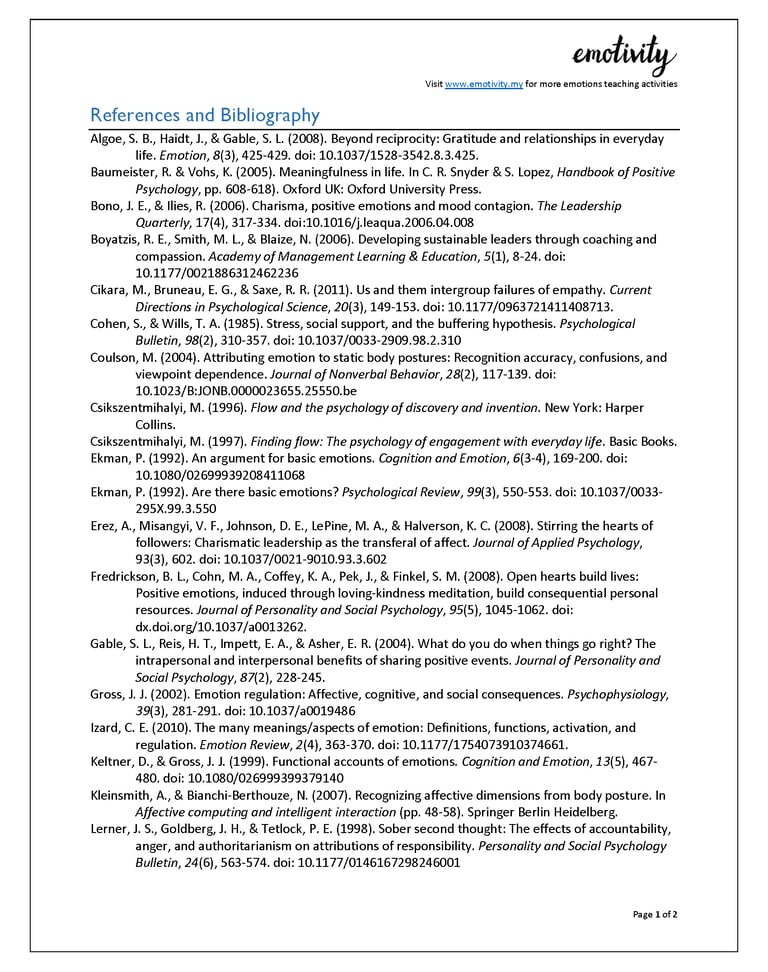LEARNING ACTIVITIES
Need some ideas on how to teach students about emotions?
Here’s a list of different activities related to emotion self-awareness, emotion self-management, perceiving emotion and use of emotions – the four sub-skills related to emotional intelligence.






Read Me First
Read this documentation for a guide on how to make the best use of the activities listed here.
Index of All Activities
References
To Get Started...
An index of all activities listed on this page, grouped by subskill, activity time, level of self-disclosure and difficulty.
Supporting references and bibliography for all activities.


Emotions and their Functions
What functions do our emotions serve? This simple exercise helps participants understand the links between discrete emotions and their functions.
All Activities


Seeing Faces
Our brains have a peculiar habit of seeing faces in things that, well, aren’t faces to begin with. Use this activity to highlight this particular quirk, and to demonstrate how emotions are communicated via facial expressions.


Getting into Flow
Flow states are experiences of psychological immersion, and are often positive emotional experiences that can stave off rumination. Use a simple coloring activity here and see if it helps you get into a state of flow.


Sketching Your Emotions
What might your emotions look like – and what colour will they be? This exercise helps show some links between emotions and physiological (i.e. bodily) responses.


Identifying Basic Emotions
This simple exercise helps participants identify and list the six basic emotions.


Managing Worries
This exercise helps participants identify elements of a worrisome situation and helps from ruminating or catastrophizing events that have yet come to pass.


Relating with Empathy
Empathy helps us see, and appreciate the emotions experienced by others, and is an important skill in cultivating emotional intelligence. This interactive exercise introduces empathy to participants, and provides tips on how to listen with empathy.


Cultivating Resonant Relationships
Meaningful, healthy relationships can help us build resilience and provide a buffer against unpleasant emotions. Use this self-reflection exercise to outline your resonant relationship network.


Reappraising Failure
Failures, setbacks and mistakes are emotionally unpleasant, but we can learn from them. Use this exercise to help participants realize that failures can be excellent resources for self-improvement.


Influencing with Emotion
Part of being influential – and charismatic is knowing another person’s emotions and making appeals to others’ feelings. This activity helps participants see how, and why emotional appeals work.


Coaching – Compliance and Compassion
Coaching with compliance and coaching with compassion are two different approaches to helping others develop. Use this activity to help participants see the difference between these two coaching approaches.


Setting SMART, Motivating Goals
Effective goals are also energizing, motivating ones. Learning to set SMART goals helps with driving intention, action and persistence towards a desirable outcome.


Letters of Gratitude
Writing letters of gratitude is a classic, well-supported approach to countering the effects of unpleasant emotions, build resilience, and enhance significant personal relationships. This simple writing exercise shows participants how to write such letters.


Identifying Flow Activities
What activities can you use to get into flow? Being immersed in, and engrossed in an activity you find intrinsically pleasurable can yield positive psychological benefits. Why not use this activity to identify and engage in flow activities?


Black and White Thinking
Anger can bias us towards thinking in absolutes. Use this exercise to help participants see that anger can have this effect on our thoughts, and suggest some ways to counter such polarized thinking.


What Is This Body Telling You?
Can we infer emotion from body postures? This short quiz activity helps participants recognize that some emotions can be observed from non-verbal, non-facial cues and bodily postures.


Constructively, Actively, Meaningfully
How we respond to others when they share good news with us can influence their feelings. Use this exercise to help participants cultivate a more mindful, considerate response to others who share positive events with us.


Categorizing Emotions
This grouping exercise gets participants to label, categorize and systematically group emotions depending on its pleasantness and intensity.


Limiting Unhealthy Comparisons
Have participants identify their basis for such comparisons in this activity, which also helps them recognize that envy stems from comparisons in areas which are relevant and personally meaningful to us.


Expressing Emotions Creatively
How might you draw your emotions? Artistic expressions has been used as an outlet for emotions, and features in some form of psychological therapy as well.


Three Good Things
Counting one’s blessings has been shown to be an effective way to cultivate beneficial feelings of gratitude.


Letter of Self-Compassion
Studies have shown that writing a letter of self-compassion is an effective approach to cultivating resilience and positive emotions towards oneself.


Values and Inspiration
This discussion-focused activity helps participants identify values important to them, and targets of inspiration that drive their actions.
Happy, or Happier?
Most people in this world are about as happy as they have made up their minds to be. Use this activity to show how Lincoln’s wisdom holds more true today in light of the evidence from psychological science.


Tribes and Explorers
This group activity divides participants into two seemingly opposing teams, before getting them to realize that the best resolutions to conflict is to focus on similarities, not differences.


Gratitude and Group Significance
Yes, you are important, but so too are those you work with. Use this activity to cultivate gratitude and appreciation between groups.


Loving-Kindness Meditation
Scientific evidence suggests there are a host of benefits associated with frequent meditation practice. This activity introduces participants to a form of meditation referred to as metta meditation.


Being Part of Something Greater
This activity helps participants see their roles, contributions and unique skills in light of a greater good, and works well with other activities aimed that providing a short-term motivational boost.


Emotion, Thought, and Action
Emotions, thoughts and behaviours are intimately linked. This simple exercise helps participants see the associations between them.


Cooperation, Coordination, and Conflict
Emotions influence how much we choose to trust, cooperate or compete with others. This activity helps participants recognize how team dynamics are shaped by perceptions and emotions within group settings.
